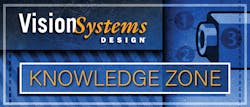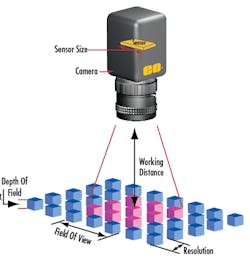Machine Vision Optics
Machine vision optics, also known as lenses, focus incoming photons of light reflected off the object of interest onto the image sensor housed inside the camera. The optical system is as critical to overall image quality as illumination.
Because a machine vision system extracts necessary information from digital video or image data, the application at hand will determine the required image quality. A system with sufficient image quality for presence/absence applications may not be sufficient for gauging applications or for flat panel display inspection.
The imaging ability of a system is the result of the imaging ability of the components. To specify the appropriate lens for your application, there are variety of parameters and concepts that need to be understood.
Field of view (FOV) is the viewable area of the object under inspection, i.e. the portion of the object that fills the sensor in the camera. Working distance is the distance from the front of the lens to the object under inspection. Necessary image resolution is determined by the minimum feature size of the object under inspection.
Depth of field is the maximum object depth that can be maintained entirely in focus. It is also the amount of object movement (in and out of focus) allowable while maintaining an acceptable focus for the application.
Sensor size, or the size of the active area of a sensor in a machine vision camera, typically specified in the horizontal dimension, is important in determining the proper lens magnification required to obtain a desired FOV.
Contrast, telecentricity, and lighting rolloff are other significant considerations when choosing the correct optics for an application. A thorough discussion of lenses and optics would go well beyond the limits of a general survey of machine vision.
As lens choice can dramatically affect the appearance of an image, machine vision system designers are advised to learn as much about optics as possible. Vision Systems Design provides an informative article, “Choosing the correct optics,” on vision-systems.com.
Another key optical system component are optical filters. All too often they are only considered after the system is in place, for troubleshooting purposes. Although optical filters are a great tool to optimize an already existing system, they are best considered in the conceptual stage of the application. Filters can be used to control quality and quantity of light, block all unwanted ambient lighting, pass only the output of lighting used for inspection, and increase contrast and resolution.
If you want to learn how to gain better control of your machine vision applications with optical filters, please read “Choosing optical filters for machine vision systems” on vision-systems.com.

